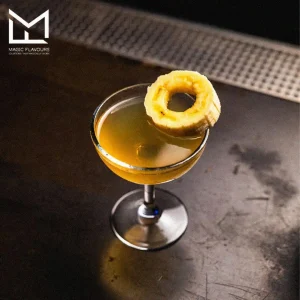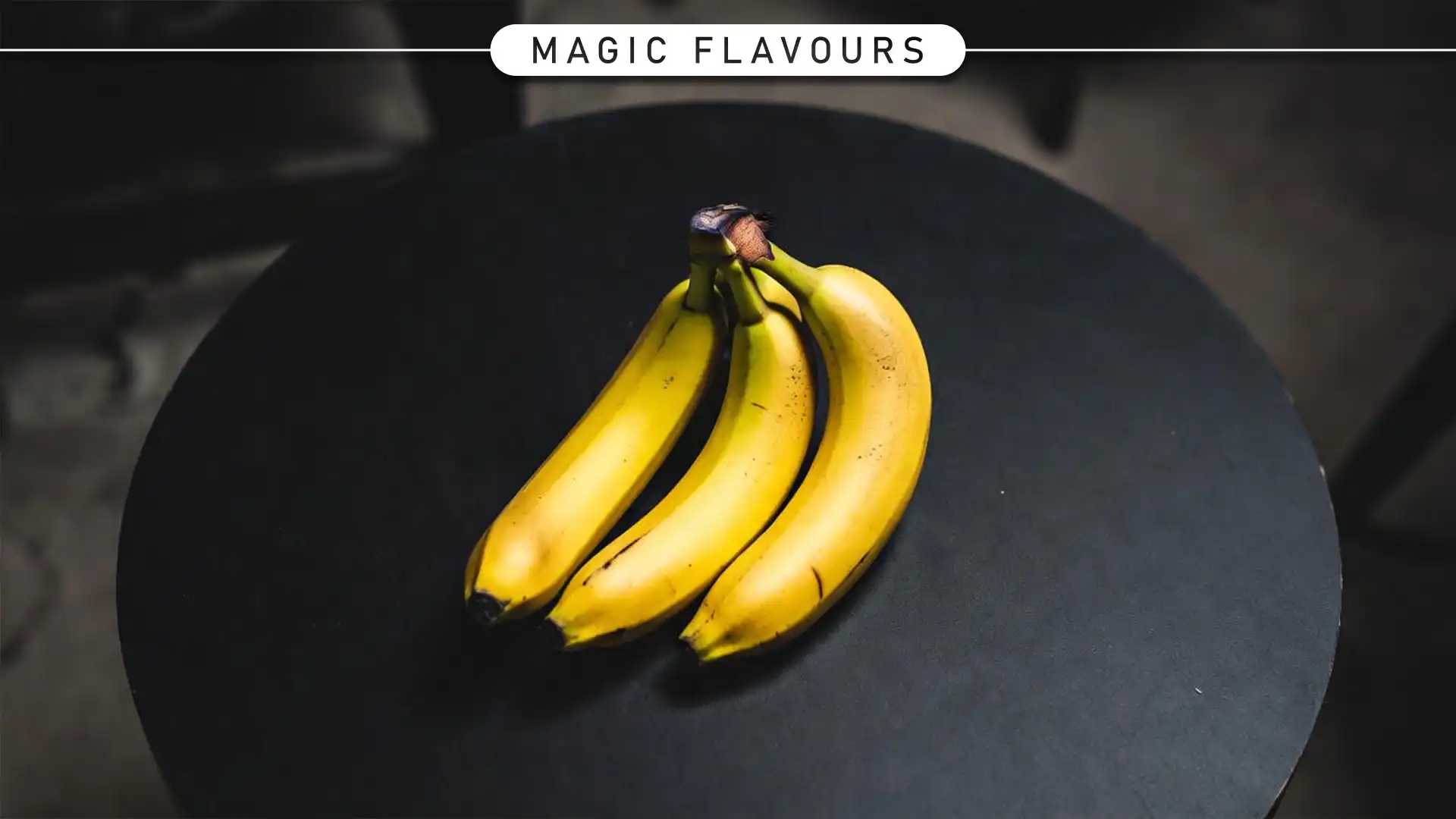1. Banana Flavor Introduction: Banana as a Global Flavor Icon
A fruit that transcends borders and cultures
Banana is one of the few fruits loved worldwide. It appears in Asian markets, Latin American plantations, and European kitchens. Moreover, its soft sweetness makes it approachable across cultures. Therefore, both children and adults embrace banana as a comforting flavor.
Why Banana Flavor is one of the world’s most recognized and loved flavors
Banana flavor is instantly recognizable. It reminds people of childhood snacks, refreshing drinks, or indulgent desserts. Moreover, its adaptability allows it to be creamy, fruity, or candy-like. As a result, banana remains relevant in different industries and product categories.
From traditional recipes to modern applications
Historically, banana appeared in simple dishes such as puddings or breads. Today, it enriches smoothies, candies, ice creams, and cocktails. In addition, banana has become central in hookah and gourmet desserts. Therefore, it continues to evolve from tradition to modern innovation.
2. The Chemistry Behind Banana Flavor
Key compounds: isoamyl acetate (the “banana ester”) and supporting notes
Banana’s signature aroma comes from isoamyl acetate, known as the “banana ester.” Moreover, natural bananas contain hundreds of volatile compounds. For example, 1-hexanol adds green notes, while others provide creamy undertones. Therefore, flavorists carefully balance these molecules to meet consumer expectations.
Ripe vs. green banana profiles in flavor creation

Banana flavor changes during ripening. Green bananas taste starchy, earthy, and slightly bitter. However, ripe bananas are sweet, mellow, and tropical. Some consumers prefer candy-like ripe notes, while others value authentic green tones. Consequently, flavorists replicate both profiles for different markets.
Balancing natural, creamy, and fruity tones
Banana is both creamy and fruity. Therefore, flavorists combine sweet esters with creamy, vanilla-like undertones. However, too much ester creates artificial intensity. Too little, and the flavor loses identity. As a result, balance is essential for authentic, appealing banana flavors.
3. The Sensory Experience of Banana Flavor
Sweet, soft, and comforting taste perception
Banana flavor is gentle and smooth. Unlike acidic fruits, it offers a mellow sweetness. Moreover, this soft profile makes banana suitable as a base flavor. Therefore, it blends well with both fruits and desserts.
Creaminess and tropical freshness
Banana has a creamy mouthfeel that resembles its pulp. Furthermore, it carries subtle tropical freshness. This combination provides both comfort and uncommon appeal. As a result, banana stands out from sharper tropical fruits like pineapple or mango.
Psychological associations: nostalgia, childhood, indulgence
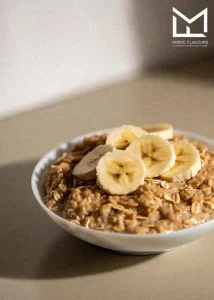
Banana flavor often triggers emotional connections. It recalls childhood candies, desserts, or simple snacks. Moreover, premium applications link banana to indulgence, such as smoothies or cocktails. Therefore, banana appeals to both playful nostalgia and sophisticated tastes.
4. Banana Flavor Across Industries
Food & Beverages
Banana is a staple in the food and beverage sector. It enriches smoothies, juices, yogurts, and ice creams with natural sweetness. Moreover, it works both as a main flavor and as a creamy support in fruit blends. However, consumer expectations differ. Some markets prefer authentic ripe banana, while others choose candy-like banana profiles in packaged drinks and snacks.
Confectionery & Bakery
Banana has long been popular in bakery and confectionery. It flavors cakes, pastries, breads, candies, and gummies. Moreover, it blends beautifully with chocolate, caramel, or nuts, creating indulgent taste experiences. Children often enjoy bold candy-like banana, while adults prefer subtle, natural tones. Therefore, banana adapts to both playful and premium creations.
Dairy Applications
Banana works naturally in dairy applications. It enhances creaminess and mouthfeel in flavored milk, yogurts, and shakes. Furthermore, it fits plant-based milks such as oat or almond, adding comfort and sweetness. As a result, banana continues to succeed in both traditional and modern dairy innovations.
Tobacco & Hookah
Banana is highly valued in tobacco and hookah products. It blends smoothly with strawberry, vanilla, chocolate, or tropical fruits. Moreover, it softens stronger flavors, making blends more approachable. However, stability under heat remains a challenge. When balanced properly, banana delivers a long-lasting aroma loved by shisha consumers.
Alcoholic Drinks
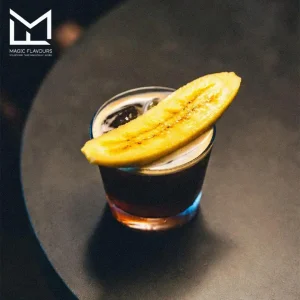
Banana also adds depth to alcoholic drinks. It shines in cocktails, liqueurs, and craft beers. Moreover, its tropical sweetness pairs well with rum and coffee-based spirits. In addition, certain yeasts naturally create banana notes in wheat beers. As a result, banana offers both playful and sophisticated appeal in the drinks industry.
5. Perfect Pairings and Synergies
Banana + Strawberry: timeless fruity classic

Banana and strawberry form one of the most beloved fruit duos. The creamy sweetness of banana balances strawberry’s tart freshness. Moreover, this pairing works well in smoothies, candies, desserts, and hookah blends. Therefore, it remains a timeless favorite across industries.
Banana + Chocolate: indulgent richness
Banana and chocolate create a flavor that feels both comforting and indulgent. The fruity softness of banana lightens chocolate’s depth. In addition, this combination appeals strongly in cakes, ice creams, and gourmet desserts. As a result, it delivers richness with balance.
Banana + Vanilla: creamy comfort
Banana pairs naturally with vanilla, enhancing its creamy and mellow profile. Moreover, vanilla softens sharp edges, creating a smooth harmony. This duo is popular in milkshakes, puddings, yogurts, and hookah blends. Therefore, it is often chosen for comfort-driven products.
Banana + Coffee/Caramel: mature sophistication
Banana takes on a new character with coffee or caramel. The sweetness of banana complements caramel’s warmth and coffee’s bitterness. Furthermore, this combination works well in desserts, liqueurs, and flavored tobaccos. As a result, it appeals to adult palates seeking sophistication.
Banana + Tropical Fruits (pineapple, mango, coconut): uncommon blends
Banana blends seamlessly with tropical fruits. Its creamy body balances the brightness of pineapple, mango, or coconut. Moreover, these combinations deliver freshness with indulgence. Therefore, they are ideal for cocktails, juices, confectionery, and shisha blends aiming for an uncommon twist.
6. Market Demand and Consumer Appeal of Banana Flavor
Banana as a familiar, low-risk flavor for consumers
Banana is widely recognized and easily accepted. Its familiarity reduces hesitation in trying new products. Moreover, brands often rely on banana to introduce consumers to new beverages, snacks, or desserts. Therefore, it remains a low-risk choice for product development.
Strong presence in children’s products, yet also premium desserts
Banana appeals to both children and adults. In children’s products, bright, candy-like flavors are popular. In premium desserts, subtle, natural notes are preferred. Furthermore, this versatility allows banana to bridge playful and sophisticated offerings across markets.
Regional preferences: natural ripe notes in Asia vs. candy-like notes in the West
Consumer preferences vary by region. In Asia, natural, ripe banana flavors are highly valued. However, Western markets often favor candy-like, intensified banana profiles. Therefore, successful flavor development requires understanding these regional tastes and adapting accordingly.
7. Innovation in Banana Flavor Development
Heat-resistant and stable banana notes for cooking, baking, and shisha
Banana flavor can change under heat, losing freshness or becoming harsh. Therefore, flavorists focus on heat-resistant, stable notes for cooking, baking, and hookah applications. Moreover, these innovations ensure banana retains its natural sweetness and aroma even in high-temperature processes.
The rise of “natural and authentic” banana flavors
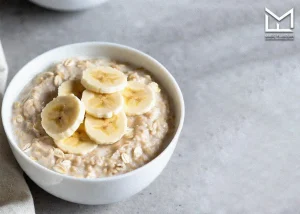
Consumers increasingly demand authentic, clean-label flavors. As a result, natural banana profiles are growing in popularity. Furthermore, these flavors replicate the richness of ripe banana without artificial or overpowering notes. This trend spans beverages, desserts, and confectionery products.
Fusions of Banana Flavor: banana milkshake, banana bread, banana daiquiri concepts
Banana continues to inspire creative combinations. For example, banana milkshake, banana bread, and banana daiquiri illustrate versatility. Moreover, these fusion concepts blend traditional comfort with modern twists. Therefore, banana remains a flexible and innovative ingredient across industries.
8. Challenges in Crafting Banana Flavor
Avoiding overly artificial, medicinal, or candy-like taste
One major challenge is preventing banana from tasting artificial or medicinal. Moreover, excessive candy-like notes can overwhelm other flavors. Therefore, flavorists must carefully control ester levels to maintain authenticity and consumer appeal.
Capturing the balance between ripe and green banana notes
Banana flavor varies significantly between ripe and green fruit. Ripe notes are sweet and mellow, while green notes are starchy and slightly bitter. Furthermore, replicating this balance is crucial for versatile applications in beverages, desserts, and baked goods.
Achieving long-lasting aroma across different applications
Banana aroma can fade quickly, especially in heated or processed products. As a result, flavorists focus on creating long-lasting, stable notes. Moreover, achieving consistency across foods, beverages, and shisha products requires precise formulation and advanced flavor technology.
9. The Future of Banana Flavor
Demand for natural and sustainable flavor solutions
Consumers increasingly seek natural and sustainable flavors. Moreover, brands focus on clean-label banana options to meet these expectations. As a result, natural banana flavors will continue to dominate product development.
Banana Flavor in plant-based and health-conscious products

Banana fits well in plant-based and health-focused products, such as smoothies, dairy alternatives, and snacks. Furthermore, its natural sweetness reduces the need for added sugar. Therefore, it is a key ingredient for modern, wellness-oriented portfolios.
Expanding fusion opportunities in global markets
Banana’s versatility encourages innovative combinations. For example, banana with tropical fruits, coffee, or chocolate creates unique experiences. Moreover, regional preferences inspire localized fusions. As a result, banana will remain central to global flavor innovation.
10. Conclusion: A Flavor That Never Goes Out of Style
Banana’s versatility across categories and cultures
Banana thrives in food, beverages, confectionery, dairy, tobacco, and alcoholic drinks. Moreover, it appeals across cultures and generations. Therefore, its versatility ensures wide application and lasting relevance.
The balance of familiarity and innovation
Banana combines comfort with creative potential. While consumers recognize its familiar taste, innovative fusions offer new experiences. Furthermore, this balance allows brands to innovate without risking acceptance.
Why Banana Flavor will always remain a staple in the flavor industry
Banana’s natural sweetness, creamy mouthfeel, and tropical appeal make it indispensable. In addition, its adaptability supports both traditional and modern products. As a result, banana will continue as a staple in global flavor development.
